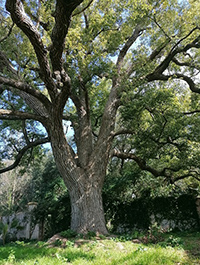Table of Contents
The camphor tree is a thousand-year-old tree that begins to produce camphor when it reaches the age of 30. In China, camphor trees are up to two thousand years old.

Camphor Tree Scientific Facts
- Other names: Laurus camphora L.
- French: Camphrier.
- Spanish: Alcanforero.
- Environment: Native to the Eastern coast of Asia (Japan, China), it is now widely grown both there and in the United States.
- Description: A tree of the Lauraceae family that grows up to 50 meters high. It has evergreen, coriaceous leaves and small, white flowers.
- Parts of the plant used medicinally: The essence of its wood.
Healing Properties and Indications

Camphor is a white, crystalline substance obtained after condensing the essential oil distilled from the camphor wood. From a chemical standpoint, it is a ketone of the borneol, an aromatic hydrocarbon with a strong aroma and an excellent, spiced flavor. These are its properties:

- Cardiac and respiratory stimulant: It stimulates the nervous centers of respiration and heart activity, increasing the frequency and deepness of breath and strengthening the heart (analeptic action). It is used for lung congestion (bronchitis, pneumonia, asthma), fainting, hypotension, arrhythmia, and blackouts.
- Antiseptic and febrifuge: Very useful for influenza and colds.
- Anaphrodisiac: Decreases sexual excitement.
- Antirheumatic and analgesic: Camphor oil or alcohol is used externally in lotions to alleviate rheumatic aches and neuralgia.
How to use Camphor
- Camphor powder: Up to 0.5g a day, divided into three or four intakes.
- Lotions and massage oils with camphor oil or alcohol are prepared by dissolving camphor in oil or in alcohol in a proportion of 10% alcohol.
Frequently Asked Question
How does the camphor tree work within the body?
Camphor has several actions:
Topically: It acts as a counterirritant, creating a cooling/warming sensation that can distract from pain. It also has mild antimicrobial properties.
Inhaled: Camphor vapors may briefly open airways, offering temporary congestion relief.
Internally (not recommended): Camphor is toxic in larger quantities. Historically, tiny doses were used for various conditions. Still, this practice is highly unsafe due to the risk of overdose.
Can the camphor tree be used to treat arthritis?
Some small-scale studies suggest camphor-containing topical preparations may offer modest relief for mild osteoarthritis pain. However, more rigorous and larger-scale research is needed to confirm these effects.
Is the camphor tree effective for respiratory issues like colds or bronchitis?
Vapor rubs: Camphor is a common ingredient in over-the-counter chest rubs. These may temporarily relieve congestion and cough due to the cooling sensation and mild airway-opening effect.
No evidence for treating the cause: Camphor doesn’t directly address the underlying cause of colds or bronchitis.
Are there any cardiovascular benefits to camphor tree use?
Unfounded claims: Some sources promote camphor for heart health, but no scientific evidence supports these claims.
Does camphor tree have antifungal properties?
In lab studies, Camphor essential oil has shown antifungal activity against certain fungal species in laboratory settings.
Real-world effectiveness: More research is needed to determine if these effects translate to treating fungal infections in humans.
Is the camphor tree safe to ingest?
No, camphor is toxic when ingested: Ingesting camphor, even in small amounts, can cause serious side effects, including seizures and potentially death. It’s only safe for topical use in appropriate concentrations or inhaling vapors from approved products.
Can camphor help with muscle aches and pains?
Potential for minor relief: Camphor-containing topical products may temporarily relieve muscle aches due to their counterirritant effect. However, they don’t address the underlying cause of muscle pain.
Are there any proven wound-healing benefits to using camphor?
Limited and mixed evidence: Some very small studies suggest camphor may have wound-healing properties. However, more extensive and more rigorous studies are needed to confirm this.
Safety concerns: There is a risk of skin irritation from camphor, especially on open wounds.
Does camphor have any interactions with medications?
Potential interactions: The breakdown of camphor in the body can interfere with how the liver processes certain medications. It’s crucial to speak to your doctor before using camphor if you are on any medication.
Who should avoid using camphor?
Pregnant or breastfeeding women: Camphor can cross the placenta and may harm a developing fetus. It may also pass into breast milk.
Children: Camphor is especially dangerous for children, even when applied topically.
People with epilepsy/seizure disorders: Camphor can increase the risk of seizures.
Anyone with liver problems: The liver breaks down camphor, and liver conditions can increase the risk of toxicity.
DISCLAIMER: All content on this website is presented solely for educational and informational objectives. Do not rely on the information provided as a replacement for advice, diagnosis, or treatment from a qualified medical expert. If you are pregnant, nursing, or have any preexisting medical concerns, talk to your doctor before using any herbal or natural medicines.
REFERENCES
- George D. Pamplona-Roger, M.D. “Encyclopedia of Medicinal Plants.” George D. Pamplona-Roger, M.D. Encyclopedia of Medicinal Plants. Ed. Francesc X. Gelabert. Vols. 1 San Fernando de Henares: Editorial Safeliz, 2000. 217. Print.
- National Institutes of Health (NIH) – National Center for Complementary and Integrative Health (NCCIH): https://nccih.nih.gov/
- WebMD: https://www.webmd.com/vitamins/ai/ingredientmono-709/camphor
- Mayo Clinic: https://www.mayoclinic.org/
- PubMed (National Library of Medicine): https://pubmed.ncbi.nlm.nih.gov/
